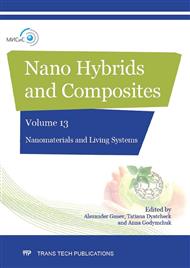p.3
p.9
p.15
p.21
p.26
p.32
p.39
p.47
Conjugates of α-Cobratoxin with CdSe Quantum Dots: Preparation and Biological Activity
Abstract:
α-Cobratoxin is the main neurotoxin in the cobra Naja kaouthia venom; it binds efficiently and selectively with neuronal α7 and muscle type nicotinic acetylcholine receptor and can be used for specific labeling and visualization of these receptors in organs and tissues. For these applications we have prepared conjugates of α-cobratoxin with CdSe quantum dots which have many benefits as compared to organic fluorescent labels. To prepare the conjugate, CdSe quantum dots with ZnS shell were functionalized using a tripeptide glutathione and coupled to toxin using water soluble carbodiimide. The conjugate was purified by gel-filtration chromatography and tested for biological activity. It was found that conjugate preserved the capacity to interact with both neuronal α7 and muscle type nicotinic acetylcholine receptor. Its cytotoxicity to mammalian cells was not higher than that of functionalized quantum dots.
Info:
Periodical:
Pages:
3-8
Citation:
Online since:
January 2017
Keywords:
Price:
Сopyright:
© 2017 Trans Tech Publications Ltd. All Rights Reserved
Share:
Citation:


